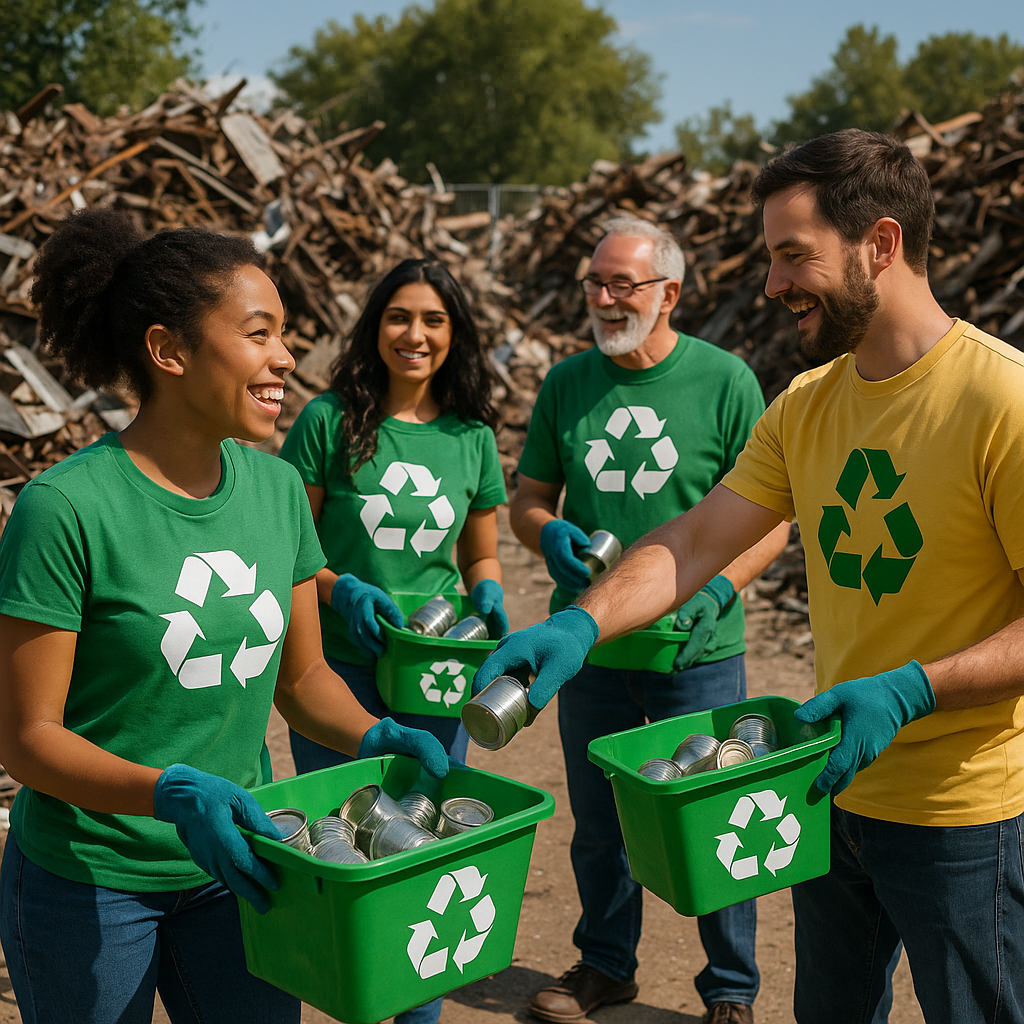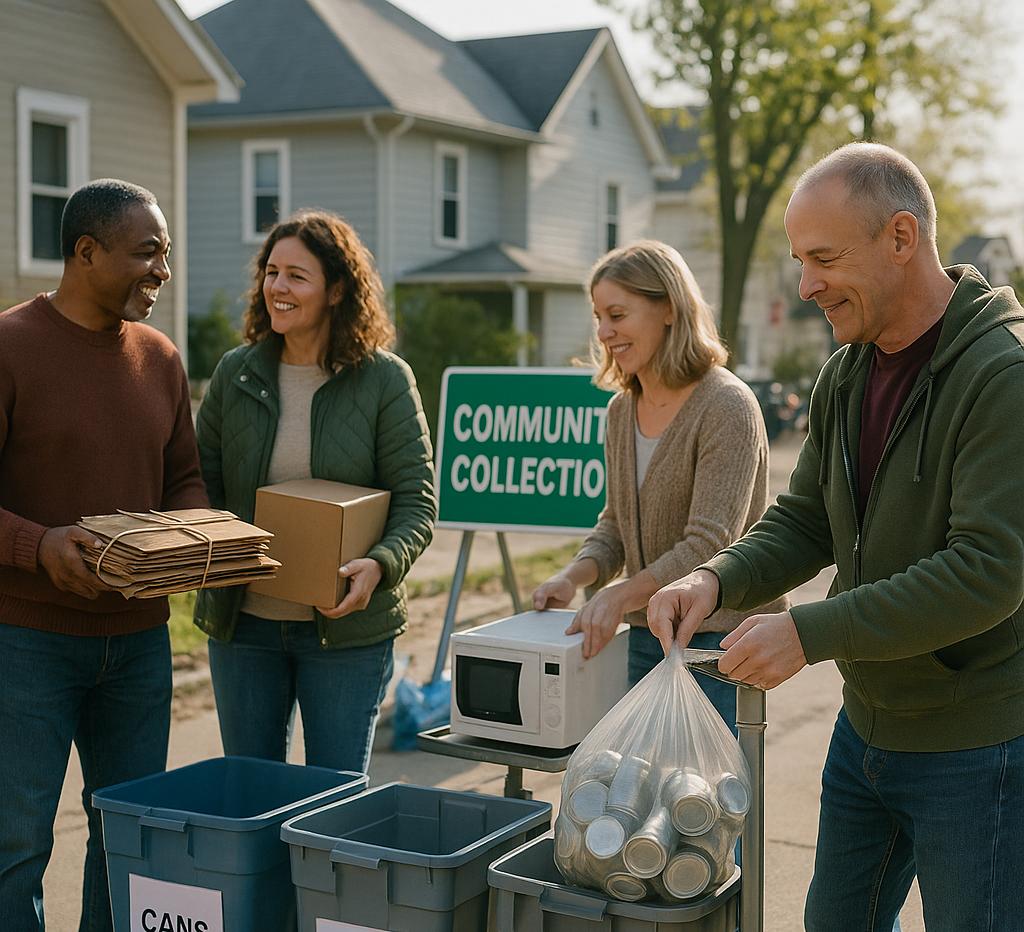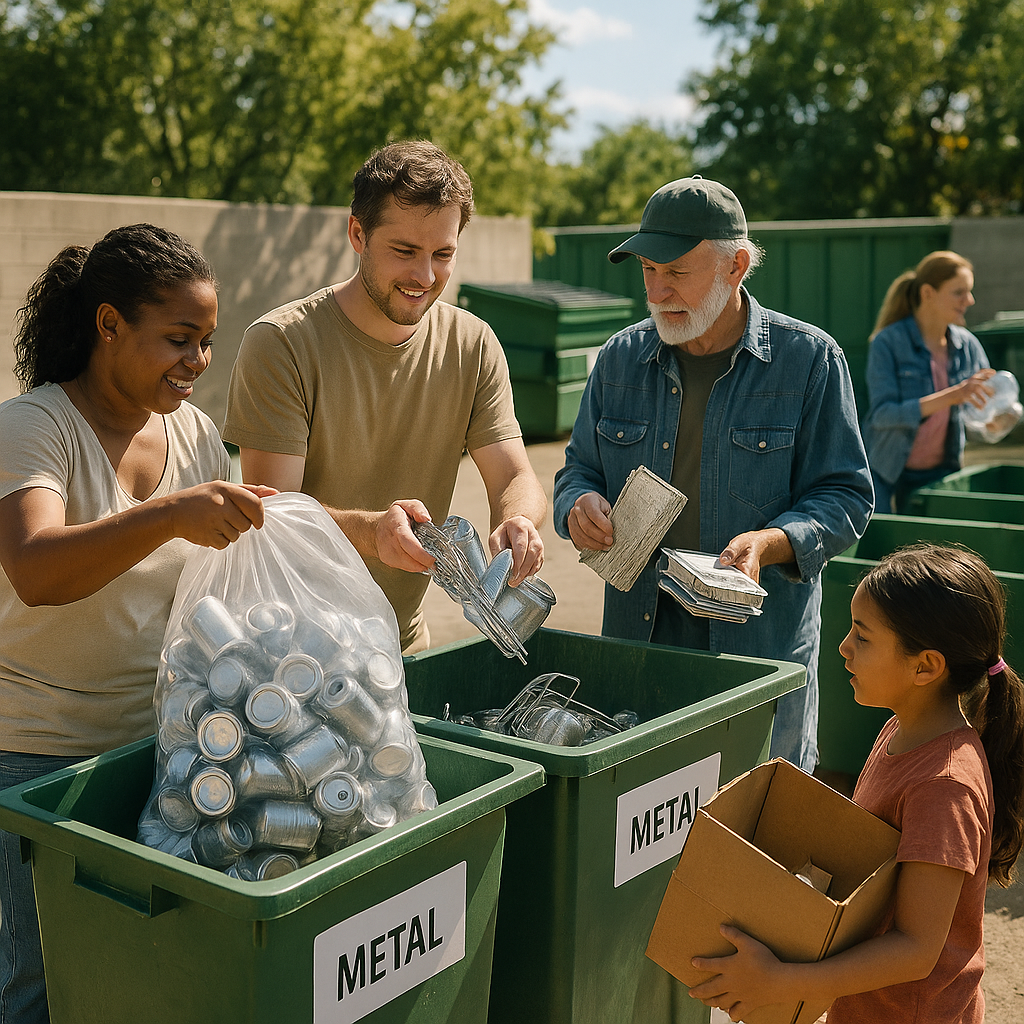5901 Botham Jean Blvd, Dallas, TX 75215
Community Scrap Partnerships with Businesses: A Guide
June 14, 2025Recycling just one ton of scrap metal saves 3,000 pounds of ore from being mined. This statistic underscores the significant impact metal recycling has on our environment. Community scrap partnerships with businesses create opportunities for environmental conservation through collaborative recycling efforts.
These partnerships are collaborative initiatives that connect local companies, community organizations, and residents. They form metal recycling networks benefiting everyone involved. By leveraging business resources and community participation, these partnerships increase recycling rates and reduce waste.
These collaborative systems are the backbone of sustainable waste management in communities. By joining forces, businesses provide expertise and infrastructure while community members contribute materials and engagement. Together, they create effective recycling ecosystems that transform discarded metals into valuable resources.
How Do Businesses Benefit from Community Scrap Partnerships?

Businesses involved in community scrap recycling initiatives gain numerous advantages beyond simple waste management. These partnerships offer opportunities for resource optimization and strengthen local community connections. Companies of all sizes can transform what was once considered waste into valuable assets through strategic collaboration.
Resource sharing is one immediate benefit for businesses joining community recycling efforts. Companies can reduce disposal costs by diverting scrap materials from landfills to recycling programs. This approach often involves less transportation and lower tipping fees compared to traditional waste disposal methods. The collective logistics network created through these partnerships also enables more efficient collection and processing systems.
Cost efficiency drives many businesses to explore recycling partnerships. By participating in community scrap initiatives, companies can significantly reduce waste management expenses. Some businesses report savings of up to 30% on disposal costs when they redirect recyclable materials to community programs rather than pay for standard waste removal. These partnerships can provide access to specialized recycling equipment that would be too expensive for individual businesses to purchase.
Environmental responsibility has become increasingly important for modern businesses. Through community scrap partnerships, companies can demonstrate their commitment to sustainability in tangible ways. This provides opportunities to showcase environmental leadership in action rather than just through corporate statements. Businesses participating in these programs can track and report their waste diversion metrics, providing concrete evidence of their sustainability efforts.
Financial and Operational Benefits
The financial advantages of community recycling partnerships extend beyond direct waste management savings. Businesses can leverage tax incentives available for donations of materials or financial support to community recycling programs. Some partnerships also generate revenue through the sale of collected materials to recycling processors, creating a situation where proper waste management contributes to the company’s bottom line.
Operational efficiency improves as businesses implement better waste sorting systems. Staff members become more aware of waste streams and often develop innovative ways to reduce material usage. Companies that actively track their recycling metrics typically identify opportunities for waste reduction at the source, preventing unnecessary purchasing and reducing overall material costs.
Supply chain sustainability becomes more achievable through community partnerships. Businesses can work with suppliers to implement packaging reduction initiatives that benefit both the company and community recycling efforts. By collaborating with other local businesses facing similar waste challenges, companies can develop shared solutions, which typically yield better results than addressing recycling challenges in isolation.
Matching donation programs represent a creative way businesses support community recycling. When a community collects a certain amount of recyclables, companies provide matching funds that amplify the environmental and social impact. In-kind contributions such as transportation services or storage space also strengthen these partnerships without requiring direct financial outlays. These arrangements create mutual benefits that sustain long-term recycling programs.
Reputation and Community Relations
Positive publicity naturally follows businesses demonstrating environmental leadership. Local media often highlight companies participating in community recycling initiatives, helping them connect with environmentally conscious consumers who prefer to support sustainable companies. Recognition as a community sustainability leader can differentiate a business from competitors in meaningful ways.
Community relationships strengthen when businesses engage in local recycling efforts. These partnerships create opportunities for meaningful interaction with residents and other organizations. Companies that participate in community clean-up events or sponsor recycling education programs build goodwill with potential customers and partners. The social connections formed through these activities often lead to other business opportunities and collaborations.
Employee engagement improves when companies participate in community sustainability initiatives. Staff members typically respond positively to working for organizations that demonstrate environmental responsibility. Involving employees in recycling partnerships can boost workplace morale and satisfaction, providing opportunities for team building while contributing to important environmental goals.
Strategic partnerships with environmental organizations further enhance business benefits. These relationships provide expertise and guidance on effective recycling practices. Organizations focused on sustainability can help businesses maximize the impact of their recycling efforts through proven strategies, demonstrating a company’s commitment to working with established environmental experts.
Marketing advantages emerge naturally from participation in community recycling initiatives. Businesses can authentically highlight their environmental efforts in marketing materials. Companies that track waste diversion metrics can include these achievements in sustainability reporting, appealing to customers and partners seeking businesses with verified environmental credentials.
Educational opportunities allow businesses to play a leadership role in community sustainability. Companies can host workshops on proper recycling techniques or sponsor school programs that teach environmental responsibility. These educational initiatives position the business as a knowledge leader while promoting better community-wide recycling practices. Sharing expertise builds credibility and strengthens the company’s reputation as a sustainability advocate.
| Benefit Category | Specific Benefits |
|---|---|
| Financial & Operational | – Reduced disposal costs (up to 30% savings) – Tax incentives for material donations – Revenue generation from material sales – Improved waste sorting systems – Reduced material costs through waste reduction – Access to specialized recycling equipment – Shared logistics networks |
| Reputation & Community Relations | – Positive publicity and media coverage – Stronger relationships with local residents – Improved employee engagement and morale – Strategic partnerships with environmental organizations – Authentic marketing opportunities – Recognition as a sustainability leader |
| Strategic Advantages | – Educational leadership opportunities – Input into local recycling policies – Access to advanced recycling technologies – Enhanced supply chain sustainability – Better long-term waste management planning – Concrete sustainability metrics for reporting |
Long-term waste management planning becomes more effective through community partnerships. Businesses gain insights into future recycling regulations and requirements through their involvement with local programs. Companies participating in community initiatives typically have more input into the development of local recycling policies, helping ensure that future waste management approaches align with business needs while serving environmental goals.
Technology sharing represents another advantage of community recycling partnerships. Businesses can gain access to advanced recycling technologies through community programs that would be cost-prohibitive individually. Collaborative technology investments allow multiple businesses to benefit from improved recycling capabilities, enhancing the efficiency and effectiveness of recycling efforts for all participants.
What Strategies Make Community Scrap Partnerships Successful?

Educational Programs That Drive Participation
Effective educational initiatives are essential for successful scrap partnerships. Communities that invest in regular workshops and training sessions help residents understand proper sorting techniques, leading to higher quality recyclable material.
Educational content should be simple and focused on key messages. Successful programs use the ‘1/5/50 rule’—tailoring content complexity to the delivery method. Signage at collection points focuses on one topic, while mailers might cover up to five topics.
Schools are excellent partners for recycling education. When local schools integrate recycling concepts into their curriculum, students often bring this knowledge home and influence family behaviors. Some communities offer school supplies or scholarships funded through recycling proceeds, creating a direct link between environmental action and educational advancement.
Financial and Recognition Incentives
Incentives significantly boost participation rates in community scrap partnerships. Financial incentives work best when they fund visible community improvements rather than individual rewards. When residents see recycling proceeds funding new playground equipment or community gardens, they develop stronger connections to the program.
Recognition-based incentives tap into social motivations. Public acknowledgment of recycling champions through local media features creates visible role models within the community. Monthly recognition programs with awards for top contributors maintain steady engagement and encourage friendly competition between neighborhoods.
Communities should implement a balanced mix of incentives appealing to different motivations. Seoul provides an excellent model by tracking residents’ recycling contributions and publicly celebrating top performers, creating both individual recognition and collective pride in sustainability efforts.
Digital Tools For Effective Outreach
Strategic digital engagement extends the reach of community scrap partnerships. Social media platforms are ideal for sharing proper recycling techniques, showcasing successful collection efforts, and building community pride. Regular posts featuring local recycling achievements create momentum and foster ongoing participation.
Mobile applications address common participation barriers by providing convenient features. Apps with collection day reminders eliminate confusion about pickup schedules. Location-based services direct residents to specialized drop-off points for items like e-waste. Some applications include barcode scanning functionality that instantly tells users whether an item is recyclable in their area.
Email newsletters deliver timely updates directly to community members. Regular communications about collection progress help residents see their collective impact. These direct communications maintain consistent engagement with recycling initiatives throughout the year.
Accessibility and Convenience Factors
Successful partnerships prioritize making recycling easy and accessible. For curbside programs, this means ensuring every eligible household receives appropriate collection containers. For multifamily dwellings, partnerships should focus on implementing on-site collection points that residents can easily access.
Drop-off locations must be strategically placed in areas where residents already travel. Sites near retail centers or along major commuting routes see significantly higher participation rates. Clear signage and regular maintenance of these locations prevent contamination issues and illegal dumping.
Partnerships should also address accessibility challenges for diverse community members. Translation features in recycling communications help overcome language barriers. Location services can identify accessible recycling points for residents with mobility challenges.
Strong Collaborative Frameworks
Clear role definition strengthens community scrap partnerships. Each stakeholder should understand their specific responsibilities within the collaborative framework. Local businesses might provide logistics support in collecting recyclables, while community centers serve as hubs for education and engagement.
Public-private partnerships offer powerful frameworks for community scrap networks. When government incentives align with business capabilities and community needs, recycling systems become both economically sustainable and environmentally effective.
Establish regular communication channels between all partners to address challenges quickly. Organizing forums where stakeholders can voice concerns and collaborate on solutions prevents small issues from becoming major obstacles. These communication channels also allow for continuous improvement based on participation data and community feedback.
Measurement and Continuous Improvement
Data collection provides the foundation for partnership improvement. Track participation rates across different neighborhoods to identify areas needing additional outreach. Monitor contamination levels to gauge the effectiveness of educational campaigns. This data helps partnerships allocate resources where they will have the greatest impact.
Regular assessment allows partnerships to adjust strategies based on what works. If data shows low participation in certain areas, partnerships can implement targeted campaigns addressing specific barriers. When contamination spikes after program changes, additional education can quickly address misunderstandings.
Share progress metrics with community members to maintain transparency and build trust. When residents see the tangible benefits of their collective efforts, such as reduced landfill waste or funds generated for community projects, ongoing participation becomes more meaningful.
How Can Communities Overcome Challenges in Scrap Partnerships?

A sunlit community recycling center where workers organize materials and people contribute to recycling efforts.
Establishing effective scrap partnerships requires communities to address several obstacles that can hinder success. Low community engagement, limited resources, and stakeholder conflicts often top the list of challenges. However, with strategic approaches and collaborative problem-solving, these partnerships can flourish and deliver significant environmental and economic benefits.
Addressing Low Community Engagement
One of the primary challenges communities face is insufficient participation from residents and local businesses. This often stems from a lack of awareness about the benefits of scrap recycling initiatives and their impact on community sustainability.
Educational workshops offer an effective solution to this problem. By organizing regular learning sessions focused on proper material preparation and sorting techniques, communities can empower residents with the knowledge needed to participate effectively. These workshops should highlight tangible benefits like landfill diversion and resource conservation.
Strategic placement of collection points also dramatically improves participation rates. Drop-off locations should be established in high-traffic areas such as community centers, school parking lots, and shopping centers. Each location should feature clear signage explaining acceptable materials and preparation requirements.
Overcoming Resource Constraints
Limited funding, equipment, and personnel often restrict the scope and effectiveness of scrap partnerships. Communities facing these constraints must develop creative solutions to maximize available resources.
Resource sharing between partner organizations creates significant efficiency gains. When businesses, non-profit organizations, and local governments pool their resources, they can share equipment, transportation fleets, and processing facilities, reducing individual operational costs.
Securing grant funding represents another valuable approach. Many environmental and community development grants specifically target recycling initiatives. Communities should research federal, state, and private foundation opportunities that align with their scrap partnership goals.
Strategic phasing of program implementation helps manage limited resources effectively. Rather than attempting to launch comprehensive scrap collection services immediately, communities can start with focused initiatives targeting specific materials or neighborhoods, then expand as resources and experience grow.
Managing Stakeholder Conflicts
Divergent priorities and expectations among participating organizations can create tensions that threaten partnership stability. Clear communication channels and transparent decision-making processes are essential for addressing these challenges.
Creating formal partnership agreements provides a solid foundation for collaboration. These documents should outline expectations, responsibilities, and benefits for each participant. When roles and expectations are clearly defined from the outset, conflicts are less likely to arise.
Regular stakeholder meetings maintain momentum and address emerging issues before they escalate. These gatherings provide forums for open dialogue where concerns can be voiced and collaborative solutions developed. The frequency of meetings may vary based on program needs but should occur consistently enough to maintain engagement.
Transparency in operations builds trust among partners. When handling materials that have potential value, such as certain metals, complete transparency regarding collection, processing, and revenue distribution is essential for maintaining collaborative relationships.
Implementing Effective Communication Strategies
Poor communication often undermines otherwise well-designed scrap partnerships. Effective information sharing requires thoughtful planning and consistent execution.
Developing multi-channel communication approaches ensures messages reach diverse audiences. Communities should utilize traditional methods like local newspapers and community bulletin boards alongside digital platforms such as social media and email newsletters. This comprehensive approach maximizes message reach across demographic groups.
Creating clear, accessible educational materials significantly improves program understanding. Materials should explain which scrap items can be recycled, how they should be prepared, and where they can be dropped off. Visual aids and simple language enhance comprehension across educational levels.
Regular updates about program achievements motivate continued participation. Sharing concrete statistics about materials diverted from landfills, environmental benefits achieved, and economic impacts demonstrates the tangible value of community involvement in scrap partnerships.
Building Sustainable Long-Term Partnerships
Some scrap partnerships start strong but falter over time as initial enthusiasm wanes. Creating sustainability in these relationships requires ongoing attention to partnership health.
Celebrating successes provides motivation for continued engagement. Public recognition events acknowledge participants’ contributions while generating renewed excitement for the initiative. These events create natural opportunities for positive media coverage, extending program messaging to potential new participants.
Continuous improvement processes help partnerships remain relevant and effective. Regular evaluation of program performance against established goals allows for data-driven adjustments. Soliciting feedback from both partners and community participants provides valuable insights into areas needing refinement.
Succession planning ensures partnership continuity despite inevitable personnel changes. Creating documentation of processes, relationships, and historical knowledge helps new leaders maintain program momentum when transitions occur. Cross-training among partner representatives builds redundancy that protects against institutional knowledge loss.
Flexibility in adaptation to changing conditions remains essential for long-term success. External factors like market fluctuations for recycled materials or shifts in community demographics require periodic reassessment of program approaches. Partnerships that can pivot strategies while maintaining core objectives demonstrate remarkable resilience.
Learning from Successful Models
Communities need not reinvent approaches to scrap partnerships. Several models have demonstrated effectiveness in diverse settings, providing valuable templates for adaptation.
The “hub-and-spoke” collection model connects smaller collection points to central processing locations. This structure allows for efficient sorting and distribution of materials while making participation convenient for residents across the community. Small-scale neighborhood collection points feed into larger processing facilities with more specialized equipment.
Incentive-based participation programs have shown remarkable success in increasing community engagement. Some communities implement point systems where participants earn credits for consistent contributions. These points can be redeemed for local products or services, creating circular benefits within the community economy.
Public-private partnerships leverage the strengths of government resources and business efficiency. When local governments provide regulatory support and public resources while private businesses contribute operational expertise, partnerships benefit from complementary capabilities that enhance overall effectiveness.
Build a Greener Future with Okon Recycling

Community scrap partnerships are more than waste reduction programs—they’re engines of environmental progress, economic efficiency, and social connection. By working together, businesses and communities can transform discarded metal into a valuable asset that benefits everyone.
If your business is ready to reduce costs, boost sustainability, and make a lasting local impact, partner with a recycling company that understands how to get it done. Okon Recycling brings the experience, equipment, and collaborative spirit needed to build successful community scrap programs across Texas and beyond.
Contact Okon Recycling at 214-717-4083 to learn how your organization can lead the charge toward a cleaner, more resourceful future.
